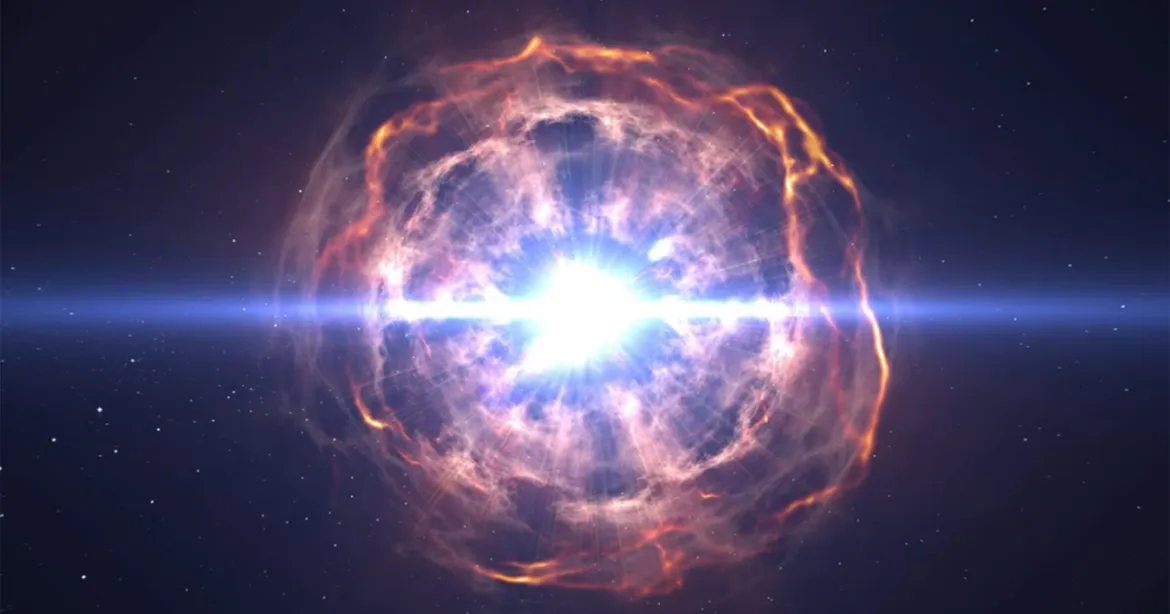Astronomers observed a supernova in real time, revealing unexpected pre-explosion outbursts in a star.
Key Takeaways
- For the first time, scientists observed a star explode in real time, witnessing the entire process.
- The red supergiant SN 2020tlf, located 120 million light-years away, was monitored for 130 days before its explosion.
- Unexpected bright flashes and gas eruptions were seen before the final collapse, challenging previous theories.
- Observations were conducted using the Pan-STARRS1 telescope and W. M. Keck Observatory in Hawaii.
- This breakthrough reveals that red supergiants may undergo dramatic internal changes before a supernova.
_________
In a monumental achievement for astronomy, scientists have, for the first time, observed a star explode in real time. The star in question, a red supergiant named SN 2020tlf, is located approximately 120 million light-years away. A team of researchers began studying the star more than 100 days before its violent collapse, using data from the University of Hawaii’s Pan-STARRS1 telescope and the W. M. Keck Observatory on Mauna Kea.
Leading up to its final supernova event, SN 2020tlf surprised scientists with bright, intense flashes and massive ejections of gas. These pre-supernova outbursts were not anticipated based on prior observations of similar stars, making this discovery especially significant. According to lead author Wynn Jacobson-Galán, a research fellow at the University of California, Berkeley, this is the first time such pre-explosion activity has been documented for a red supergiant.
Insights into Supernova Behavior
Red supergiants are the largest stars by volume, with sizes that can reach over a thousand times the radius of our sun. Although they are immense, they are not the brightest or most massive stars in existence. Like other stars, red supergiants generate energy through nuclear fusion at their core, progressively burning heavier and heavier elements as they age.
The final stages of a supergiant’s life are marked by the fusion of iron and nickel, which consumes more energy than it produces. This imbalance leads to the eventual collapse of the star’s core and results in a type II supernova, expelling the star’s outer layers into space. Prior to this event, researchers had observed red supergiants both before and after their supernovae, but never the full sequence leading up to the explosion.
The study revealed that, during the months leading to its destruction, SN 2020tlf exhibited significant instability. Observations indicated that bright flashes of radiation and gas eruptions occurred as early as the summer of 2020. These findings suggest that the star underwent severe internal changes and began ejecting material into space before its final collapse.
Raffaella Margutti, an astrophysicist and study co-author from UC Berkeley, highlighted the novelty of this discovery. She noted that it is unprecedented to confirm such dramatic pre-explosion activity in a red supergiant. The team concluded that these results could shift the understanding of the behavior of massive stars in their final phases.
The implications of this study are far-reaching. For the first time, astronomers have concrete evidence that red supergiants can become highly unstable, releasing energy and gas months before going supernova. This newfound knowledge will help scientists refine models of star life cycles and supernova mechanisms, providing a deeper understanding of stellar evolution and death.





Too many damn commercials make it very difficult to follow and read text. So I’ve stopped and will delete your page. Doesn’t matter how much I enjoy your articles if it’s so frustrating to read them